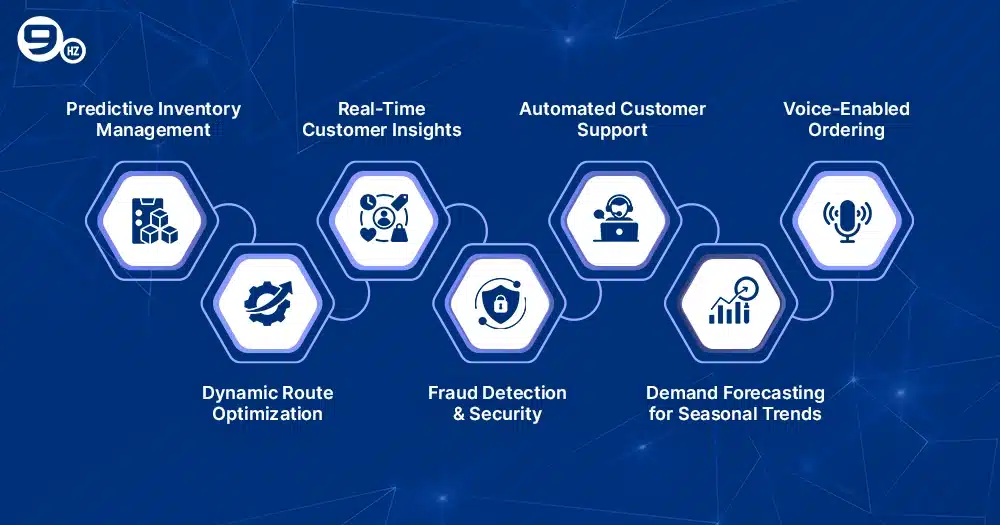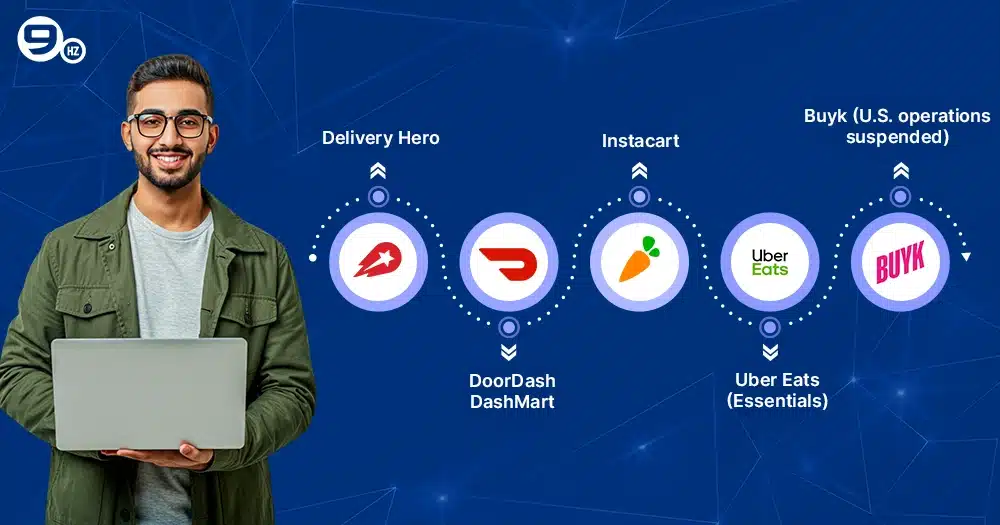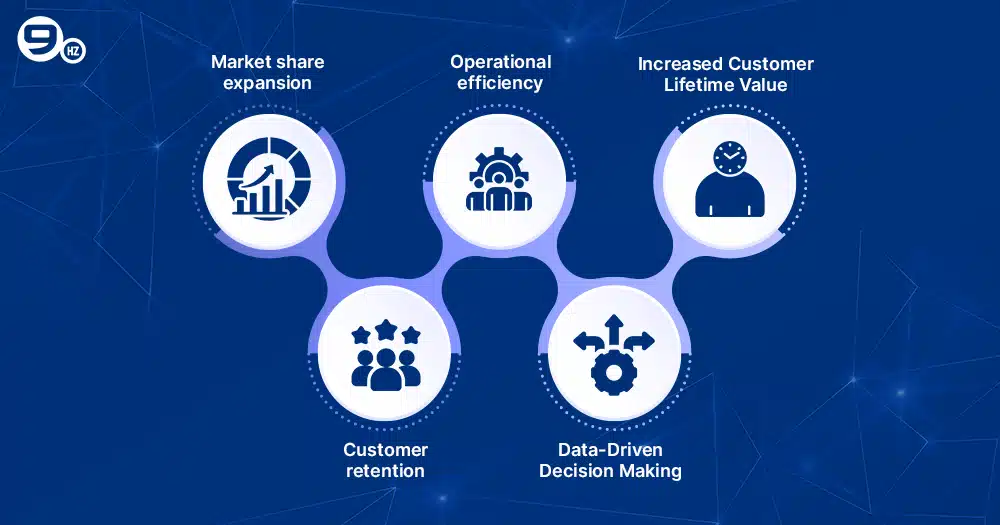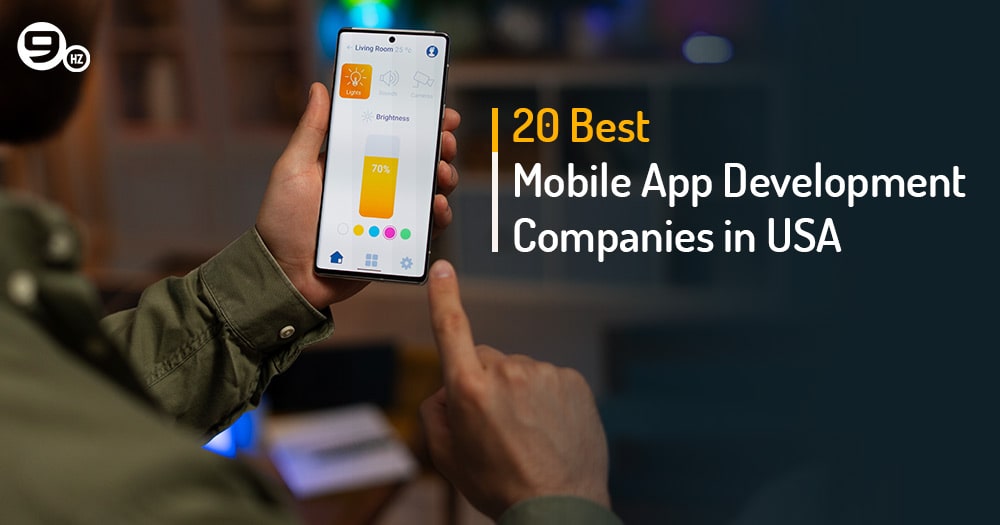Offering to provide basic products right now in only minutes, the fast commerce company is redefining what consumer expectations are. However, a somewhat complex and costly business model is really what makes this lightning-fast service feasible. As more individuals utilize Q-commerce platforms, companies have to invest more in technology, operations, and personnel to maintain reliability and service standards.
Standard e-commerce allows a greater area for products and more flexible shipment dates. In q-commerce, however, even if speed is of importance, accuracy, and consistency are always needed. This high-speed architecture often strains infrastructure and generates budgetary difficulties. This is particularly true in crowded cities where everyday chores include determining the optimal delivery routes.
According to Statista, USD 195.01 billion is the worldwide quick commerce industry projected for 2025. Still, many Q-commerce businesses struggle to turn a profit as their expenses are too high and consumer demand is often shifting. This need has driven both large-scale retailers and startups using the Q-Commerce model, which uses technology, dark storefronts, and micro fulfillment centers, to drastically decrease delivery times. So, without wasting any more of your time let’s jump right into it.
What is Q-Commerce?
Quick commerce, also known as q commerce, is a rapidly expanding internet retail niche. Its objective is to have immediate access to goods, often less than thirty. It operates via hidden stores, micro-fulfillment hubs, and local q-commerce sites positioned to provide very rapid delivery, unlike traditional retailers. These services seek to rapidly and conveniently satisfy consumers’ immediate access requirements.
Traditional e commerce, which emphasizes a wide range and longer delivery periods, differs from q-commerce. Rather, it emphasizes daily needs and fast gratification. Using artificial intelligence, machine learning (ML), and real-time operations, q commerce enterprises simplify on-demand delivery for city dwellers who want their items delivered with just a few clicks. Among the most often used items in rapid trade are:
- Grocery delivery and household essentials: Quick commerce systems are based on daily items like milk, bread, and cleaning products. Users may quickly refill their houses thanks to them.
- Personal care products: People may purchase skin care items, toiletries, and other health products in an emergency. Quickly delivering these products, Q commerce enterprises ensure client satisfaction and provide access to personal hygiene products as needed.
- Over-the-counter medicines: Quick shopping allows one to buy painkillers, allergy medications, and cold remedies straight away, without having to visit the pharmacist, for minor ailments or emergency health demands.
- Snacks and beverages: Whether it’s a late-night need or a fast pick-me-up, Q Commerce specializes in rapidly delivering beverages, chips, and sweets to consumers who want to purchase food on demand.
- Pet supplies: inadequate litter or cat food? Pet owners with complete plans or unexpected demands will find it simple as Q commerce spaces quickly supply necessary pet products.
By using ML and real-time patterns, Q-Commerce systems can forecast what consumers will desire, guaranteed availability of products, and provide greater convenience than ever before.
From Idea to App – Your Quick Commerce Solution Starts Here!
AI Impact on Quick Commerce
Artificial Intelligence is changing the quick commerce business by making it easier to make decisions faster and more customer-friendly. AI helps Q commerce companies grow while meeting customers’ growing standards for fast delivery and accuracy. It does this by managing goods and finding the best delivery methods. Here’s how to do it:
1. Predictive Inventory Management
AI algorithms can predict how much a product will be bought right now, which helps q commerce sites keep popular things in stock and reduce waste. This cuts down on costs and speeds up order processing, even when the demand is high.
Real-Life Use Case:
Machine learning helps Blinkit keep track of local buying habits and make changes to its warehouse stocking based on those trends. This inventory management system, built on AI, has helped them cut down on delivery times and make sure orders are correct in all of India’s big cities.
Pro tip: Use tools that are driven by AI to keep an eye on local spending trends and act on them right away.
2. Dynamic Route Optimization
AI is also very important for finding the best transport routes by looking at data about traffic, weather, and time of day. This makes sure that deliveries happen quickly and helps drivers avoid being late, especially in areas with a lot of people.
Real-Life Use Case:
Getir uses guidance systems that are driven by AI and adjust delivery routes in real-time. Because of this, operations are better, even during rush hour, which makes shipping very fast and increases customer happiness.
3. Real-Time Customer Insights
AI lets q commerce systems quickly look at how users behave and make personalized product ideas. Customers are happier, more likely to buy, and more loyal when they can customize their Internet shopping experiences.
Real-Life Use Case:
Based on a user’s past orders, Swiggy Instamart uses AI to suggest everyday items that are popular or often bought. By making things more personal, they get more repeat orders and lower bounce rates on their mobile apps.
4. Fraud Detection and Security
Companies that do q commerce can spot strange deals in real time thanks to advanced AI systems. This lowers the risk of theft. This makes sure that funds are safe and builds trust in Q-commerce spaces.
Real-Life Use Case:
Zepto uses AI to find strange payment patterns that quickly stop fake activities. This has greatly cut down on payment issues and made users trust its on-demand services more.
5. Automated Customer Support
Chatbots that are driven by AI answer customer questions right away and can solve problems like delayed delivery times or product availability without any help from human personnel. This provides help around the clock and lowers the cost of doing business.
Real-Life Use Case:
During busy times, Gorillas handles a lot of help tickets with micro fulfillment centers that are AI chat agents. This helps the site keep its high running costs in check while keeping customers happy.
Build Your Next-Gen Quick Commerce App with Experts
6. Demand Forecasting for Seasonal Trends
AI keeps an eye on both past and real-time data to predict when customer demand will rise because of holidays, events, or changes in the weather. This makes it easier to change the stock ahead of time so that delivery is quick.
Real-Life Use Case:
AI planning helps Instacart get ready for seasonal food store sales. It changes the amount of stock in all of its delivery centers during Thanksgiving and Christmas to meet the high demand with as few delays as possible.
7. Voice-Enabled Ordering
When AI is combined with voice assistants, users can change everyday items by speaking orders. This makes online shopping faster and easier for more people.
Real-Life Use Case:
Voice instructions from Alexa can be used to quickly reorder items from Amazon Fresh. With Amazon’s q commerce business plan, users can just say, “Reorder eggs,” and they’ll be brought before an hour.
Quick Commerce Examples
As the U.S. q-commerce business grows, a few major players are setting new standards for fast shipping and customer happiness. To meet the growing demand for food, everyday items, and more, these companies use dark stores, cutting-edge technology, and well-planned delivery routes. Let’s look at five well-known q-commerce companies that are changing the way people in the US shop online.
1. Delivery Hero
Using the shadow commerce approach, a worldwide food and shopping delivery behemoth known as Delivery Hero has created several “dark stores” in major cities. For consumers who require daily goods in record time, this shift in approach enables speedier delivery, better service, and more efficient operations.
2. DoorDash DashMart
DoorDash’s DashMart service lets the company do business with people who don’t eat at places. It has a network of nearby stores that can quickly bring food, personal care items, and even goods for pets. This plan uses DoorDash’s current delivery speed system to find the best lines for same-day delivery. With DashMart, DoorDash is embracing the future of online shopping, which is all about getting things right away.
3. Instacart
Over the years, Instacart has grown from a simple food delivery service to a major player in online shopping. It now claims delivery speed in less than an hour for everyday items, fresh food, and even personal care items in some U.S. areas. Instacart makes sure that its product is managed well and deliveries are quick by using AI and data-driven insights. This makes it easy for them to keep up with changes in how people buy things today.
4. Uber Eats (Essentials)
By adding an “Essentials” section to its app, Uber Eats has moved into the quick-buy market. This makes it as easy for users to order drinks, snacks, and home things as it is to order food. Uber makes deliveries super fast by using its current fleet and optimizing delivery routes. This also increases value for customers who prefer on-demand delivery through familiar mobile apps.
5. Buyk (U.S. operations suspended)
Before stopping operations in the U.S. in 2022 because of money problems, Buyk offered service in less than one hour in New York and Chicago. The company worked through dark stores and wanted to send everyday items very quickly. Even though Buyk isn’t doing business in the U.S. anymore, its problems show how important it is to keep high operating costs under control in the quickly changing q commerce industry.
Note: These businesses are great examples of how quick commerce can make life easier, faster, and more flexible in cities.
Speed Up Sales with Lightning-Fast Q-Commerce Solutions
What are the Benefits of Quick Commerce?
Going with a quick shopping plan is very helpful for both customers and companies. As on-demand services become more popular, Q commerce platforms are not only meeting people’s urgent needs, but they are also changing what they expect from brands. Whether it’s about getting things right away or running things more efficiently, quick commerce is still a very important part of the future of online shopping.
For Consumers
1. Convenience:
People can quickly and easily get their everyday essentials or have home deliveries of groceries. This amount of ease makes online shopping a lot easier to do, especially in cities with lots of people.
2. Instant gratification:
Instant delivery on Q commerce platforms lets people buy things on the spot, whether they need items for a meal they forgot or a gift they need right away. This fits perfectly with how modern consumers act and their desire for lightning-fast delivery.
3. 24/7 access:
Many q commerce companies are open 24 hours a day, seven days a week, unlike many brick and mortar stores. People can always get over-the-counter medicines, snacks, and personal care items when they need them because the store is open 24 hours a day, seven days a week.
4. Time-Saving Convenience:
Quick shopping systems save busy people time because they don’t require them to go to stores. With just a few taps on their phones, users can have everyday items brought right to their door, making life easier and more convenient for people who are always on the go.
5. Reduced Last-Minute Stress:
Instant delivery makes things less stressful, whether you forget an item for dinner or a school supply. Quick commerce services give customers peace of mind by quickly meeting unplanned wants. This changes how and when people shop.
For Businesses
1. Market share expansion:
Businesses can quickly reach new areas and groups of people without having to open real grocery stores. By using q commerce sites, they can get into competitive markets without having to spend a lot of money on space or getting things set up.
2. Customer retention:
Customers are more likely to stay loyal if you offer fast delivery through quick trade. Customers who are happy are more likely to buy from you again, which increases customer happiness and improves how people see your brand in the quick commerce space.
3. Operational efficiency:
Companies can make inventory management easier, cut down on waste, and find the best delivery paths by using AI and ML. This makes delivery services smaller and cheaper in the q commerce business model.
3. Data-Driven Decision Making:
Businesses can guess what customers will want, change their stock, and set the best prices by using ML and data-driven insights. This helps people make better choices and makes managing supplies and focusing campaigns more efficient.
4. Increased Customer Lifetime Value:
Faster completion makes people more loyal. People are more likely to buy from Quick commerce companies again if they get their items right and on time. This makes customers happier, builds trust in the brand, and raises the possibility of lifetime revenue, an important measure in the fast-paced world of online shopping.
Pro tip: In a time when customers want things right away, adding a quick shopping option to your site will help it stay useful.
How to Implement Quick Commerce
Making the switch to a quick business plan isn’t just about speeding up shipping. It needs a total change in how things are shipped, how technology is set up, and consumer behaviour. Unlike regular online shopping, q commerce systems are designed to send daily items right away, most of the time in 30 minutes or less. Here are some tips for companies that want to use a quick commerce business plan and stay competitive in this fast-paced field.
1. Set Up Local Fulfillment Centers and Dark Stores
For lightning-fast delivery, companies need to put money into local warehouses or dark stores that are close to places with a lot of demand. These small locations are necessary to cut down on shipping times and make customers happier because they hold limited, high-turnover items.
Key Steps:
- Use data-driven insights to look at area demand and shopping habits.
- Hold only the most important things to make pick-and-pack go faster.
- Pick places that are close to major delivery paths.
2. Leverage Technology and Automation
Smart programming is what makes a quick commerce platform work well. ML and AI help keep track of goods, find the best transport routes, and make internet shopping more personal. These tools help businesses run more efficiently and grow.
Tech Must-Haves:
- Tracking of goods in real-time
- Automation of order handling and delivery
- Use of predictive analytics to predict demand
3. Build a Reliable Delivery Infrastructure
In q business, speed is everything. Companies that want lightning-fast delivery need a well-organized delivery system, such as a team of riders or a relationship with a third-party delivery service.
Logistics Tips:
- Use GPS to find the best way on the fly.
- Offer delivery on the same day or in less than one hour.
- Allow tracking in real-time through mobile apps
4. Choose the Right Product Mix
Since there is only so much room, focus on high-demand items like food delivery, personal care items, and over-the-counter medicines. Choose items that are good for getting quick satisfaction and using them often.
Smart Product Strategies:
- If you want to limit slow-moving or special items
- Choose SKUs based on data about items that sell quickly or partner with brick and mortar stores.
- Change your stock often to keep up with changes in consumer demand.
5. Ensure Strong Customer Engagement
Use app-based messages, reward programs, and smooth UI/UX to keep people coming back. This not only raises standards for customers but also helps the competitive quick commerce business grow.
Engagement Best Practices:
- Use app-based alerts to keep track of orders and offer deals.
- Give savings or prizes to people who use your service often.
- Make sure that the UI/UX of quick commerce websites and mobile apps stays smooth.
Tip: Businesses can move beyond standard e-commerce and into the future of online shopping, which will be driven by fast delivery, ease of use, and smart use of data, by using these strategies.
What is the Future of Q-Commerce?
Quick business presents a clear, rapid, and ever-growing data-driven future. Quick commerce systems will get more individualized, efficient, and long-lasting as time passes and people’s requirements evolve. From artificial intelligence to transportation systems, every aspect of the modern commerce business model is preparing for significant changes in the coming few years. These are some main trends and forecasts over the foreseeable future:
1. Hyper-Personalized Shopping Experiences
AI-driven personalization will enable fast shopping systems to offer products depending on past behavior, current location, and time of day. By providing hand-picked options based on real-time demands and purchase behavior, this approach makes consumers happy.
Use Case:
Instacart already proposes that a customer “Buy Again,” based on prior purchases. This motivates people to do this and simplifies internet buying.
2. Drone and Autonomous Deliveries
Self-driving delivery robots and drones will help to reduce the need for human riders, therefore accelerating delivery and lowering labor costs. These innovative technologies are perfect for rapid sales of over-the-counter medications or personal hygiene products in crowded settings.
Real-Life Example:
Using Amazon Prime Air and Alphabet’s Wing, a few locations in the United States are currently attempting drone delivery for minor goods. This is opening the path for Q Commerce Services’ future.
3. Sustainable Q-Commerce Operations
Environmental responsibility will grow in significance as e-commerce businesses, under increasing pressure to reduce pollution, pay attention to sustainability. Companies must figure out how to satisfy consumers’ expectations for rapid delivery while simultaneously using greener strategies such as eco-friendly packaging, electric automobiles, and improved delivery lines. This will ensure long-term expansion free from compromise of speed, efficiency, or consumer standards.
Key Practices:
- Electric autonomous delivery vehicles
- Biodegradable packaging
- Batch deliveries to reduce traffic emissions
4. Expansion into Rural Markets
Although quick commerce platforms are now concentrated in cities, they are also getting ready to penetrate suburban and rural locations. By leveraging autonomous distribution centers, online grocery stores, and adaptable transportation systems, companies may provide services not available on typical e-commerce platforms. This will create new client bases and facilitate daily item access for those living in locations not well-served.
Real-Life Example:
Setting up temporary dark stores, Walmart is trying rapid delivery services in small areas of the United States.
5. Voice Commerce Integration
People will recreate daily activities using devices like Alexa and Google Assistant as speech technology develops. Fewer steps and on-demand delivery made possible by voice commerce will enable consumers to be happy and simplify the user experience. It would also let businesses in Q-commerce get speedier checkouts and better mobile app conversion rates.
Use Case:
GoPuff includes voice technology so that consumers, via smart speakers and smartphone applications, may make orders and track them straightforwardly.
6. Brick and Mortar Retailers Going Hybrid
Many e-commerce firms are releasing limited product lines to help with profit management and differentiate their brands. These private-label products, which mainly include food, household essentials, and personal care items, increase client loyalty, simplify inventory control, and help platforms become less reliant on other brands. This allows sites additional flexibility to satisfy customer demand in real-time.
Examples:
- Gopuff’s “Basically” essentials line
- DashMart’s in-house personal care products
7. Real-Time Inventory and Dynamic Pricing
AI-powered technologies will enable q shopping systems to monitor supply levels and adjust pricing in real-time. By thinking about topics like shelf life, local events, and weather patterns, businesses may reduce garbage, increase income, and ensure items are constantly accessible for consumers who are altering their purchasing behavior.
Real-Life Example:
To keep things fresh and reduce overstocking, Zepto instantly alters the cost of swiftly deteriorating goods.
8. Integration with IoT Devices
Smart equipment will automatically purchase additional supplies from associated online commerce websites when supplies are running short. Let consumers replace food delivery or personal care products without any issues by means of swift delivery automation, which forecasts instead of responds to consumer behavior. This increases the efficiency of processes and makes quick commerce even more a part of daily life.
Use Case:
The Samsung Family Hub refrigerator can place food and drink orders, and features related to internet commerce sites rearrange themselves.
9. Data-Driven Predictive Fulfillment
AI and ML will enable companies to forecast consumer demand patterns and build up pre-stocking facilities in a manner that satisfies those demands. This prediction approach reduces delivery times, increases customer satisfaction, and eliminates unnecessary stock by preparing orders before consumers even place them. It is redefining online shopping going forward.
How it Works:
- Analyze purchase trends
- Anticipate high-demand items
- Pre-pack for fast delivery
10. Consolidation and Partnerships
Businesses will combine or create alliances as the QCommerce market expands to increase their operations. These linkages will allow businesses to exchange technologies, consumer information, and transportation infrastructure. In the hectic environment of on-demand services, this will enable businesses to remain competitive, reach more customers, and save expenses.
Example:
Uber joined up with Gopuff to provide fast shopping items on the Uber Eats app. This lets individuals locate objects more easily and expands the scope of their baskets.
Pro tip: Companies should constantly examine consumer data to guarantee they can fulfill orders quickly and better grasp demand patterns.
Conclusion on Quick Commerce
Quick commerce has evolved into a potent extension of ordinary e-commerce in a world where speed and simplicity of use are more vital. It changes people’s shopping behavior and brings basic necessities at record speed, therefore fulfilling their increasing need for instant gratification.
Along with dark stores and small fulfillment facilities, the q commerce area is bursting with new innovations like AI-driven operations and self-driving delivery trucks. Adopting Q-Commerce is not just a trend for new or existing stores; it is also a requirement if you want to stay ahead in the corporate environment of today.
Work with The NineHertz if you wish to develop a solid platform for fast trading. Our talented developers build mobile applications and adaptable, quick commerce websites fit for real-time operations and speedy delivery. Give you cutting-edge technology that increases speed, customer delight, and long-term development to help you stay up to the high expectations of your consumers.
FAQS
1. What do you mean by quick commerce?
Quick commerce, or quick commerce, is the on-demand delivery of food, everyday items, and other things within minutes, usually in less than one hour. In contrast to standard online shopping, it focuses on fast shipping through dark stores and local processing centers.
2. Is quick commerce available in the USA?
Yes! Quick trade sites are growing very quickly in the US. Now, companies like Gopuff, DoorDash’s DashMart, and Instacart offer lightning-fast delivery in all big U.S. cities. This has changed the way people shop online.
3. What are the examples of quick commerce companies?
GoPuff, Instacart, DoorDash, DashMart, Uber Eats Essentials, and Buyk are all well-known q commerce companies. The efficient delivery system of these platforms makes it possible for snacks, food, over-the-counter medicines, and more to be delivered very quickly.
4. Which quick commerce is best?
Depending on where you live, GoPuff is often thought to be the best because it has a huge selection, reliable delivery services, and is open 24 hours a day, seven days a week. It stands out in the quick commerce business because it focuses on quick satisfaction and has a wide range of products.
5. How do I start quick commerce?
Set up dark stores in your area, pick a mix of products that people want, make a quick mobile app driven by AI, and work with delivery services to start a quick commerce business. Machine learning and ideas based on data can also be used to improve user experience and product management.
6. What are the top-selling categories on quick commerce?
Grocery delivery, personal care items, snacks and drinks, pet supplies, and over-the-counter medicines are some of the most popular categories. These things meet customers’ needs for speed, ease of entry, and everyday comfort.
7. Who are the top quick commerce players in the US?
Gopuff, Instacart, DoorDash, DashMart, and Uber Eats Essentials are some of the biggest q commerce companies in the U.S. These platforms are the leaders in fast delivery because they use local distribution centers and transport infrastructure that is connected to technology.
8. What is the biggest online store in the US?
Amazon is still the biggest place to shop online in the United States. It is the leader in both standard and new forms of e-commerce. For example, Amazon Fresh and Prime Now, which offer same-day delivery in some areas, are examples of new forms of q-commerce.













